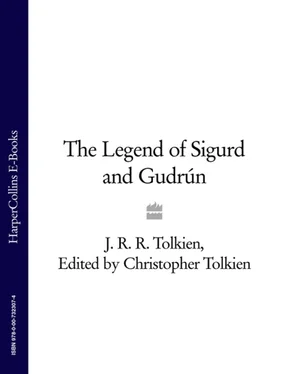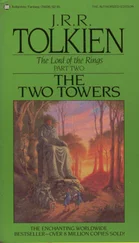J. Tolkien - The Legend of Sigurd and Gudrún
Здесь есть возможность читать онлайн «J. Tolkien - The Legend of Sigurd and Gudrún» — ознакомительный отрывок электронной книги совершенно бесплатно, а после прочтения отрывка купить полную версию. В некоторых случаях можно слушать аудио, скачать через торрент в формате fb2 и присутствует краткое содержание. Жанр: Старинная литература, на английском языке. Описание произведения, (предисловие) а так же отзывы посетителей доступны на портале библиотеки ЛибКат.
- Название:The Legend of Sigurd and Gudrún
- Автор:
- Жанр:
- Год:неизвестен
- ISBN:нет данных
- Рейтинг книги:5 / 5. Голосов: 1
-
Избранное:Добавить в избранное
- Отзывы:
-
Ваша оценка:
- 100
- 1
- 2
- 3
- 4
- 5
The Legend of Sigurd and Gudrún: краткое содержание, описание и аннотация
Предлагаем к чтению аннотацию, описание, краткое содержание или предисловие (зависит от того, что написал сам автор книги «The Legend of Sigurd and Gudrún»). Если вы не нашли необходимую информацию о книге — напишите в комментариях, мы постараемся отыскать её.
The Legend of Sigurd and Gudrún — читать онлайн ознакомительный отрывок
Ниже представлен текст книги, разбитый по страницам. Система сохранения места последней прочитанной страницы, позволяет с удобством читать онлайн бесплатно книгу «The Legend of Sigurd and Gudrún», без необходимости каждый раз заново искать на чём Вы остановились. Поставьте закладку, и сможете в любой момент перейти на страницу, на которой закончили чтение.
Интервал:
Закладка:
This latter part of the prose passage, which is found in closely similar form in the Saga, tells that Sigurd rode up onto Hindarfell ( Hindarfjall ) and turned south. On the mountain he saw a great light, as of a fire burning, and it lit up the sky; and when he came to it there stood a shield-wall ( skjaldborg ), and above it a banner. Sigurd went in to the skjaldborg , and saw a man there lying asleep, with all his armour and weapons. First he took the helmet from his head; and then he saw that it was a woman. The hauberk was so tight that it seemed to have grown into the flesh. Then with his sword Gram he cut the hauberk from the neck and along both sleeves, and he took the hauberk off her; and she woke, and sat up, and saw Sigurd.
It will be seen that stanzas 2–4 of the Lay follow the content of this prose passage quite closely, with the ‘wall of woven shields’, the standard, and ‘her corslet fast as on flesh growing’; but the leaping of the flames by Grani is an addition in the Lay, taken from Sigurd’s second visit to Brynhild, when he came to her in Gunnar’s shape. On the occasion of his first coming to her the sources say no more than that he ‘went in’ to the skjaldborg. This word, which is found both in the Saga and in the prose passage in the Edda, is often interpreted to mean here a tower, or a fortress, but my father referred in other writing to Brynhild having ‘surrounded herself with a wall of flame’.
With the Valkyrie’s first words to Sigurd the verses of the so-called Sigrdrífumál begin:
Hvat beit brynju?
Hvi brá ek svefni?
Hverr feldi af mér
fölvar nauðir?
What bit the mail?
How am I roused from sleep?
Who has cast down from me
the pale bonds?
Then in this opening verse Sigurd replied that the son of Sigmund with the sword of Sigurd had cut her free. This verse is in fornyrðislag , but the poem that follows is in ljóðaháttr (see note to V.42–44), with a few stanzas in fornyrðislag . The Valkyrie celebrates her awakening in verse that is echoed in the Lay in stanzas 5–6, and then says:
Long did I sleep, long was I cast in sleep,
long are the ills of men!
Ódin ordained it that I could not break
the runes of slumber.
There follows then in the Codex Regius manuscript another prose passage beginning ‘She named herself Sigrdrífa, and she was a Valkyrie’; she told Sigurd that two kings had fought, that Ódin had promised victory to one of them, but the Valkyrie had felled him in the battle. In retribution for this ‘Ódin stabbed her with the sleep-thorn’ (as in the words of the Raven in V.52), and said that never again should she win victory in battle, but that she should wed. ‘And I said to Ódin that in return I made a vow that I would marry no man who knew fear’ (the same words are used in the Saga). In the version of Snorri Sturluson she vowed to wed none but the man who should dare to ride through the fire that surrounded her dwelling. In her oath in the Lay (VI.8) the original text had ‘world’s renown’: I have adopted the late change to ‘chosen’ and capitalized the ‘w’.
The name Sigrdríf or Sigrdrífa of the sleeping Valkyrie has given rise to a great deal of speculative discussion. In the last of the five ‘bird-verses’ that constitute the end of Fáfnismál (and which are represented in the Lay by stanzas V.50–54) there is a reference to ‘the sleep of Sigrdríf’, and in the prose passage just cited she is twice named Sigrdrífa. It has been supposed that this name is unreal, a misunderstanding on the part of the compiler of the Codex Regius, who took the word in the Fáfnismál verse to be a proper name, whereas it is in fact a descriptive term of a Valkyrie, perhaps meaning ‘giver of victory’, used of Brynhild. In the Saga the Valkyrie on Hindarfell is called Brynhild; while Snorri Sturluson says that she named herself Hildr (which means ‘battle’), but adds that ‘she is called Brynhild, and she was a Valkyrie’.
On the other hand, it has been held that ‘Sigrdrífa’ and ‘Brynhild’ were originally two distinct beings who came later to be identified; and thus ‘Sigrdrífa’ becomes an element in the most intractable problem of the Norse Völsung legend, the treatment in the sources of Brynhild in two altogether distinct and incompatible ways. The Lay itself provides no evidence of my father’s view of the name ‘Sigrdrífa’, which does not occur in it. See further the Note on Brynhild, p.243.
The prose passage in the Codex Regius ends, after the Valkyrie’s words to Sigurd concerning her vow, by his asking her ‘to teach him wisdom’, and there follows a stanza in which Brynhild brings him ale brewed with good spells and gamanrúna , which may be translated as ‘joyful runes’ or ‘gladness runes’. On this is founded stanza 12 in the Lay: the last lines of this, ‘rimmed with runes of running laughter’, suggest that my father was thinking of runes graven on the cup.
Of the Sigrdrífumál he remarked: ‘This poem, more than almost any other in the Edda, is a composite thing of more or less accidental growth, and not as one poet left it’; and following the verse about the bringing of ale there is a long series of verses concerned with rune-lore (the magical use of runes, for example victory-runes, speech-runes, wave-runes, birth-runes, and the places on which they should be carved). ‘It does not need much persuasion’, he said, to ‘convince one that all this stuff is accretion. It has no connection with Sigurd’s later life. Its cause is gamanrúna . It is very interesting and important, but it does not concern the Völsungs.’
It is remarkable that the author of the Völsunga Saga included all these verses of runic lore, as verses, in his text. My father saw in this a good example of the saga-writer’s method: ‘Nearly all of this has no point or significance for the tale, is probably a late addition, is not fit for prose; here was a chance if anywhere for omission, if the compiler had been inspired with a truly artistic purpose.’
There is naturally no vestige of these verses in the Lay. In the Eddaic poem the Valkyrie now gave to Sigurd a series of eleven counsels. This element appears, though in greatly reduced form, in the Lay (stanzas 15–16); my father believed them to be, unlike the rune-lore verses, part of the original poem, since they can for the most part be related to Sigurd’s story.
No more is to be learned from the Sigrdrífumál about the first meeting of Sigurd and the Valkyrie beyond her counsels to him, for no more of the poem is preserved: it is here that the ‘great lacuna’ of the Poetic Edda begins. This is the calamitous loss from the Codex Regius of a whole gathering, probably of eight leaves (see p.28): my father guessed that those leaves contained perhaps 200–300 stanzas. For this vitally important part of the Völsung legend there is no Eddaic poetry, except for four fornyrðislag stanzas quoted in the Völsunga Saga ; and thus from this point the sources are the Saga and the very brief version in Snorri Sturluson’s Prose Edda. The lacuna ends, in terms of the Lay, at stanza 46 in its last section.
My father believed that the troth-plighting of Sigurd and Brynhild (stanza 19), which is found in the Saga immediately after a prose paraphrase of the counsels, derived from the lost conclusion of the Sigrdrífumál.
20–23 The Saga, after the words ‘and this they swore to each other with oaths’, continues at once ‘Now Sigurd rides away’. The conclusion of this section of the Lay, referred to in the prose preamble that precedes it (‘They depart together, but the pride of Brynhild causes her to bid Sigurd depart and come back to her only when he has won all men’s honour, and a kingdom’), is a development altogether peculiar to the Lay.
Читать дальшеИнтервал:
Закладка:
Похожие книги на «The Legend of Sigurd and Gudrún»
Представляем Вашему вниманию похожие книги на «The Legend of Sigurd and Gudrún» списком для выбора. Мы отобрали схожую по названию и смыслу литературу в надежде предоставить читателям больше вариантов отыскать новые, интересные, ещё непрочитанные произведения.
Обсуждение, отзывы о книге «The Legend of Sigurd and Gudrún» и просто собственные мнения читателей. Оставьте ваши комментарии, напишите, что Вы думаете о произведении, его смысле или главных героях. Укажите что конкретно понравилось, а что нет, и почему Вы так считаете.












